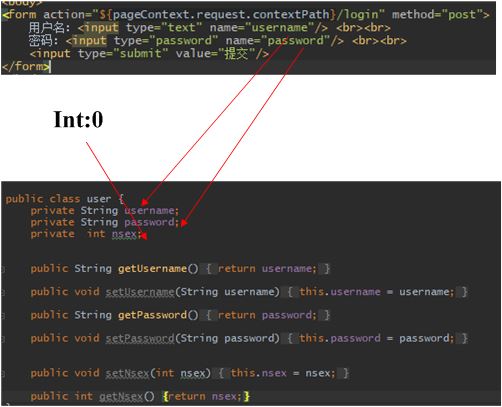溫馨提示×
您好,登錄后才能下訂單哦!
點擊 登錄注冊 即表示同意《億速云用戶服務條款》
您好,登錄后才能下訂單哦!
1、通過注解ModelAttribute直接映射表單中的參數到POJO。在from中的action寫提交的路徑,在input的name寫參數的名稱。
POJO
package com.demo.model;
public class user {
private String username;
private String password;
private int nsex;
public String getUsername() {
return username;
}
public void setUsername(String username) {
this.username = username;
}
public String getPassword() {
return password;
}
public void setPassword(String password) {
this.password = password;
}
public void setNsex(int nsex) {
this.nsex = nsex;
}
public int getNsex() {return nsex;}
}
FORM
<%--
Created by IntelliJ IDEA.
User: wym
Date: 2019/10/8
Time: 23:17
To change this template use File | Settings | File Templates.
--%>
<%@ page language="java" contentType="text/html; charset=UTF-8"
pageEncoding="UTF-8"%>
<!DOCTYPE html PUBLIC "-//W3C//DTD HTML 4.01 Transitional//EN" "http://www.w3.org/TR/html4/loose.dtd">
<html>
<head>
<meta http-equiv="Content-Type" content="text/html; charset=UTF-8">
<title>Login</title>
</head>
<body>
<form action="${pageContext.request.contextPath}/login" method="post">
用戶名:<input type="text" name="username"/> <br><br>
密碼:<input type="password" name="password"/> <br><br>
<input type="submit" value="提交"/>
</form>
</body>
</html>
CONTROLLER
package com.demo.controller;
import com.demo.model.user;
import com.demo.service.Userservice;
import org.springframework.beans.factory.annotation.Autowired;
import org.springframework.stereotype.Controller;
import org.springframework.web.bind.annotation.ModelAttribute;
import org.springframework.web.bind.annotation.RequestMapping;
import org.springframework.web.bind.annotation.RequestMethod;
import javax.servlet.http.HttpSession;
@Controller
public class LoginController {
@Autowired
private Userservice userService;
@RequestMapping(value="/login", method= RequestMethod.POST)
public String hello(@ModelAttribute user u, HttpSession session){
session.setAttribute("user", u);
user user = userService.findbyname(u.getUsername());
if(user == null)
return "loginfail";
else if(!user.getPassword().equals(u.getPassword()))
return "falsepaswd";
else
return "helloworld";
}
}
注意!!這里只有input的參數name名稱和pojo中的成員域名稱完全相同才可以通過@ModelAttribute進行直接映射,否則無法被賦值的參數將會以默認值的方式呈現。

2.顯然不可能form獲取的內容總是某個pojo的屬性,完全有可能是單獨出現的。這時可以使用@RequestParam獲取參數。
public String hello(@RequestParam(value="username") String A, @RequestParam(value="password") String B, HttpSession session){
session.setAttribute("a", A);
session.setAttribute("b", B);
user user = userService.findbyname(A);
if(user == null)
return "loginfail";
else if(!user.getPassword().equals(B))
return "falsepaswd";
else
return "helloworld";
}
這時候只需跟在@RequestParam后的參數和form的name一致即可,String的名稱可以隨便取。
3.可以直接啥注解都不加,只需保證參數名稱和form的name即可
public String hello( String username, String password, HttpSession session){
session.setAttribute("a", username);
session.setAttribute("b", password);
user user = userService.findbyname(username);
if(user == null)
return "loginfail";
else if(!user.getPassword().equals(password))
return "falsepaswd";
else
return "helloworld";
}
4.通過HttpServletRequest接收
public String hello( HttpServletRequest req, HttpSession session){
username=req.getParameter("username");
password=req.getParameter("password");
session.setAttribute("a", username);
session.setAttribute("b", password);
user user = userService.findbyname(username);
if(user == null)
return "loginfail";
else if(!user.getPassword().equals(password))
return "falsepaswd";
else
return "helloworld";
}
此外,還有一些其他的方式接受數據,例如通過@RequestBody等方式傳遞json數據。
以上就是本文的全部內容,希望對大家的學習有所幫助,也希望大家多多支持億速云。
免責聲明:本站發布的內容(圖片、視頻和文字)以原創、轉載和分享為主,文章觀點不代表本網站立場,如果涉及侵權請聯系站長郵箱:is@yisu.com進行舉報,并提供相關證據,一經查實,將立刻刪除涉嫌侵權內容。